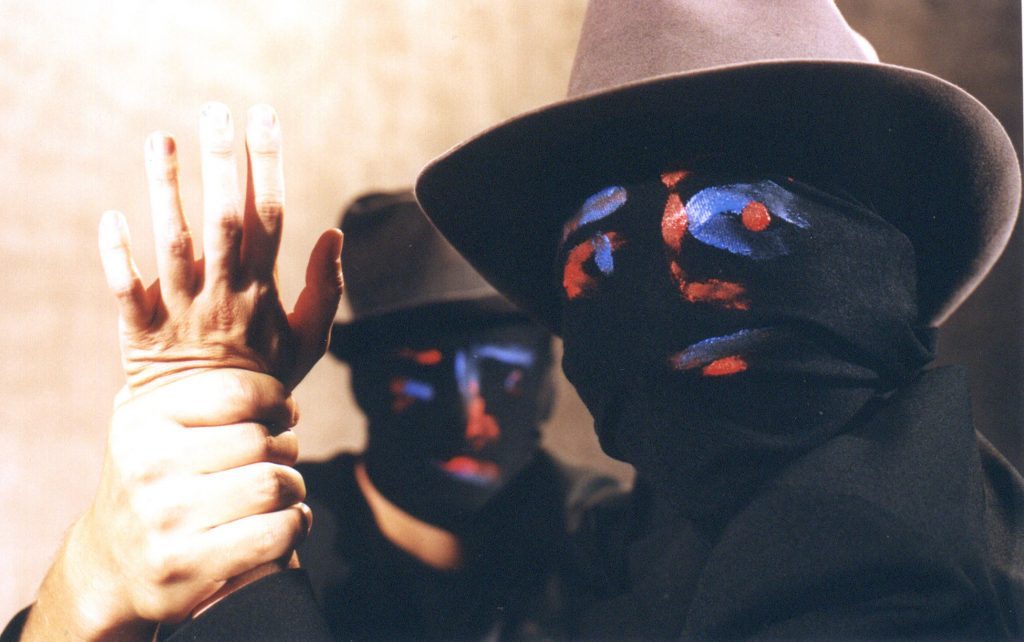Trailer:
The performance of ARTUS was inspired by the study of Lipót Szondi entitled “Cain the lawbreaker and Moses the lawmaker.”
Obviously, ”Cain’s hat” is neither a philosophical work nor a psychoanalytical study on fate, or illustration of different theories. It is hard – sometimes even impossible – and unnecessary to “decompile” the scenes to the original ideas and abstract thoughts which served as a starting point of the work process. The clue of deciphering the images lies in the images themselves, the “intentions” – like yarns of a tacking work – slowly fell off the material in the course of the rehearsals, and what remained made up the genuine fabric of the performance: the reality of the myths that were approached/written over with a profane eminence, and serene humor. Movement-music, fine arts influenced dance, body – poetry, thought – theatre. Representation that is whole in its details. ARTUS.
(Cain did not even have a hat)
The hat has not been here from eternity. The hat needed to be invented. The ones constantly forced to flee kept holding their hands over their heads – fearing the revenge of Yahweh -, until it simply stayed there. Or something like that.
The hat has been a special object ever since then: the symbol of respect, concealment, defense and protection. It sets apart and connects, protects and conceals. It implies humility and fear. It either covers the Cain-seal, or as it may, it itself is a seal.
(Moses and the Cain-seal)
The patterns: “Cain” and “Moses”.
Cain killed. He killed his younger brother with a rock. There is hardly anything more that we happen to know about him. Cain is the Killer. Moses killed too. Later, he carved into the stone tablet: DO NOT KILL. Moses is the lawmaker.
Cain represents the eternal emblematic figure of the jealous fratricide, however, the Cain – seal is worn by Moses, too. Cain is the master of disguise. He conceals himself: all kindness, all mask. Moses is rebellious and humble. In order to control his own aggression, he creates laws, which he subsequently forces onto everybody. And if somebody does not obey, the Cain’s-anger breaks out from him.
The performance can thus be viewed as a sequence of variations on the story of Cain, told in several different ways. And our task is to search for the sense of things: we inherited the anger and the laws; the whole never-ending rampage.
(But Everyone’s Got a Stone)
In the beginning was the Stone… Stone in the heart. Stone in the hand. Stone in the head. You could also be Cain if suddenly you were to become one of many, where once you were the only One. Where everything that once belonged to you becomes common property. And where is Abel? Poor Abel. (Poor Stone).
Lest you should stray from the straight and narrow, lest you should fail to erect a strong barrier in the path of your emotions, you carve the Commandment into the stone (this way everyone can imprint it on their mind). You don’t strike with the stone, you strike it; you compose with heavy blows.
When the stone tablet is ready, the Law will stand. If you break it, it will come down heavily on you. (And then everything will be reduced to ruins…)
Photo gallery
Reviews in French, English & Hungarian
Céli Barbier: Chain’s hat french review
Andor Deutsch: Stone Hungarian
Mary Brennan: Cain’s hat
Tamás Halász about Cain’s hat in Ellenfény (2000/7.)
Further documents
When & where
CAST
Performers:
BAKÓ Tamás, GODA Gábor, GOLD Bea, KISS Erzsi, PINTÉR Béla
Composer:
KISS Erzsi
Light designer:
KOCSIS Gábor
Costume designer:
REMETE Kriszta
Collaborators:
KERTÉSZ Nóra, LUKÁCS Rita, Ernst SÜSS
Special thanks to:
OLDAL István, CSABA Krisztina, MOHÁCSI András, MOLTÉSZ Gyula, UPOR László
Director-coreographer:
GODA Gábor
Supported by Fonó Budai Zeneház, Albeo Kft., Soros Alapítvány, NKA, NKÖM, Fővárosi Önkormányzat Kulturális Bizottsága, ARTUS-SOROS mobil színházi technika




